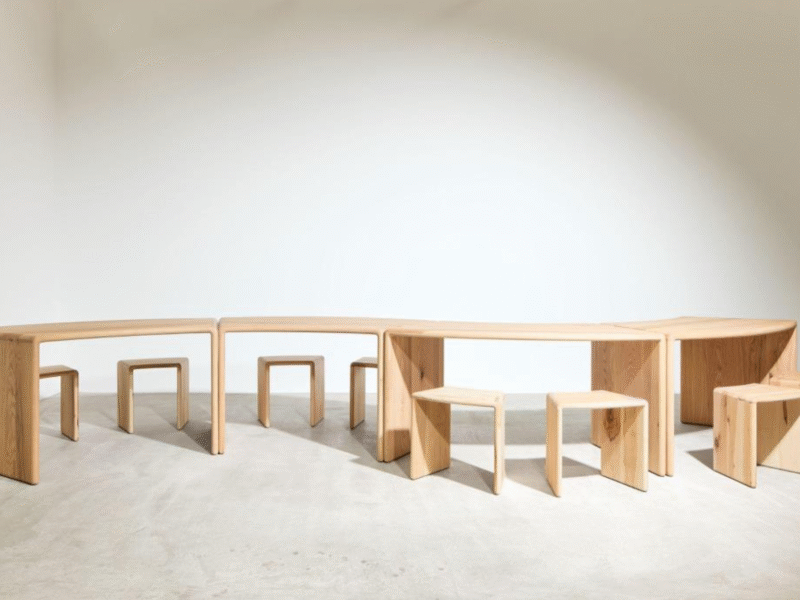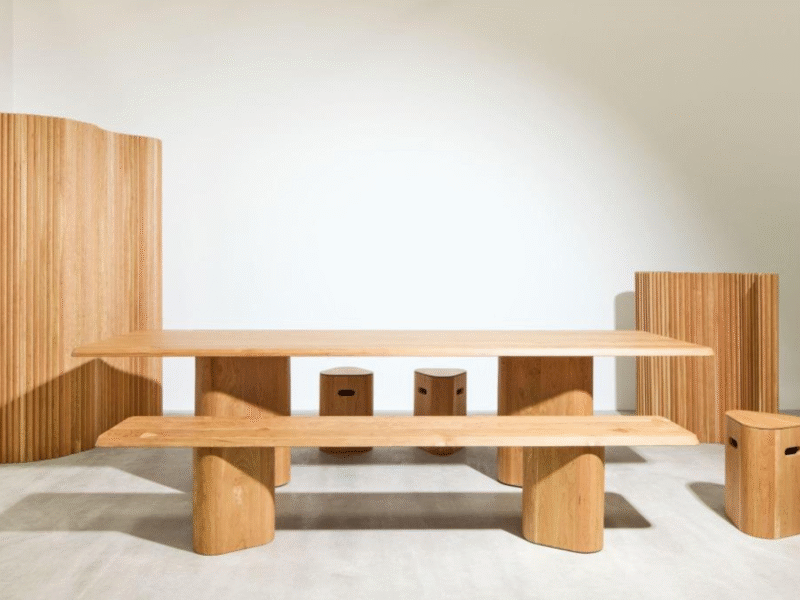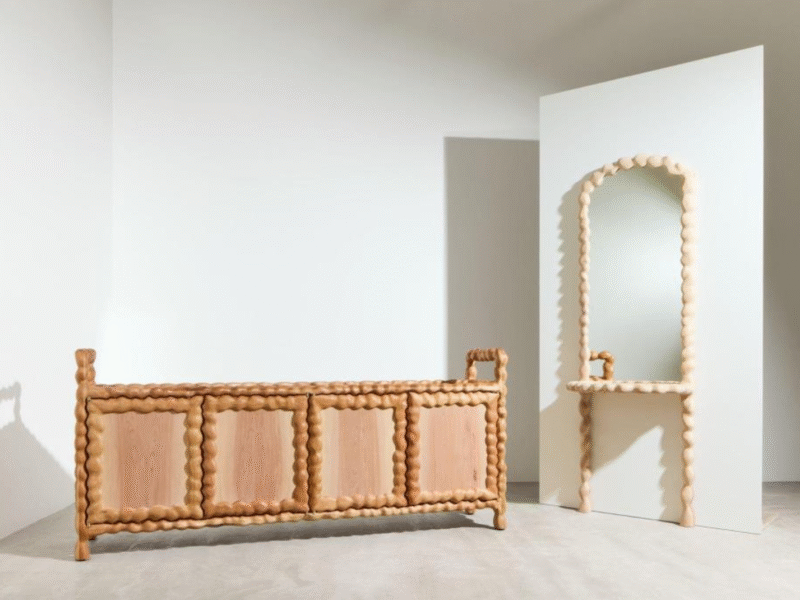No.1 Common at Material Matters
‘No.1 Common’ at Material Matters
Three designers uncovered wood’s natural beauty at 3daysofdesign
Material Matters, June 2025
The No.1 Common exhibition showcased the potential of ‘cabinet grade’ hardwood as a versatile and desirable design material. Image by Dan Medhurst, courtesy of AHEC.
Timber and furniture producers across the world label lumber based on knots, characteristics, and variations in colour and grain. No.1 Common is not commonly used in Europe, which tends to favour clearer timber grades. The exhibition celebrated a sustainable approach to material selection – to ‘use what nature provides’. AHEC commissioned new works by designers Andu Masebo, Daniel Schofield and Anna Maria Øfstedal Eng to celebrate the natural variety of timber.
Earlier this month, the exhibition No.1 Common opened in Copenhagen to make the case for often-overlooked hardwood qualities and species in design. Three visionary designers unveiled unique works at the festival’s Material
Matters fair, each championing a sustainable approach to material selection: ‘use what nature provides’.
The beauty of the overlooked
American hardwood forests contain more than twice the volume of standing timber today as 50 years ago. To maximise the potential of this natural resource, we need to rethink how we use timber – learning to appreciate and utilise not just the most ‘pristine’ cuts, which make up only 10–15% of the tree, but as much of the tree as possible.
Debuting at Material Matters, No.1 Common questioned what quality means in natural materials and highlighted how sustainable and thoughtful material selection can shape the future of our forests and our world. The exhibition demonstrated the shared power and responsibility that designers, industry leaders, and consumers have in prioritising environmentally conscious decisions – rather than simply following trends that don’t always respect the rhythms and needs of nature.
What is No.1 Common?
Timber and furniture industries across the world label lumber based on factors such as cutting area size, number of knots, and colour and grain variation. In the U.S., these determine the grade, which reflects the percentage of ‘clear wood’ in a board. Number 1 Common (No.1C) hardwood generally comprises a similar amount of clear wood as higher grades but in smaller cuttings. Although originally created as the ‘cabinet grade’, this timber is not commonly used in Europe, where clearer grades are preferred.
Launched at 3daysofdesign, AHEC’s No.1 Common project made the case for broadening the usage categories of this grade. It presented three visually and texturally unique designs to showcase the potential of No.1C hardwoods as aesthetically rich, high-performance materials.
The project was inspired by hands-on research conducted by Benchmark, commissioned by AHEC, to explore the technical, aesthetic, and practical possibilities of No.1C timber in furniture. Their work assessed its benefits in terms of labour efficiency and yield.
Following this phase, AHEC commissioned three designers to create works that highlighted both the beauty and practicality of No.1 Common timber – producing designs that contributed to a more sustainable future.
One grade, three designs
‘Around Table’ by Andu Masebo
London-based designer Andu Masebo brought his background in ceramics, metal fabrication and carpentry to the project, retaining a focus on simplicity, accessibility and materiality.
For No.1 Common, Masebo designed a dynamic tablescape that transformed over the three days of the festival, facilitating events centred around human connection.
The table, made from No.1 Common red oak, comprised eight curved segments that were reconfigured in different ways throughout the exhibition. As the surface evolved, it served as a stage for objects that encouraged interaction – and a canvas for traces left by each event.
A set of semi-stackable stools in No.1 Common brown maple echoed the table’s design language, offering flexibility and creating a cohesive collection.
‘Common Room’ by Daniel Schofield
Based in Copenhagen, British designer Daniel Schofield combined skills from his background in graphic design and carpentry. His project Common Room explored how adaptable furniture can serve new working needs while connecting users with nature.
Schofield used No.1 Common cherry to create a family of furniture – table, bench, stools, and screens – embracing the material’s variation in colour, knots and grain. Rather than concealing these characteristics, he developed techniques to showcase them, including softened butterfly joints adapted for machine production. This distinctive triangular form defined the collection’s design language.
‘Kontur Series’ by Anna Maria Øfstedal Eng
Norwegian designer Anna Maria Øfstedal Eng created a cabinet and wall mirror using characterful No.1 Common yellow birch. Inspired by roots and branches, her work explored contrast and natural form.
Through collaborative experimentation with Benchmark, Øfstedal Eng discovered a rich range of colour in yellow birch. Laminating boards with different tones and grains, she carved layered structures that revealed organic patterns and silhouettes, highlighting the timber’s expressive potential.
These sculptural pieces contrasted with light, clean surfaces on cabinet fronts and tabletops – creating a dialogue between expressive and minimal forms that showcased the versatility of No.1 Common hardwood.
No.1 Common: rethinking timber grades for a sustainable future



